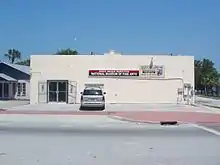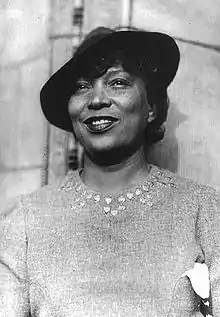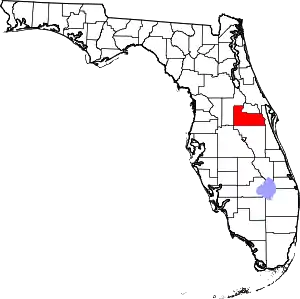Eatonville, Florida
Eatonville is a town in Orange County, Florida, United States, six miles north of Orlando. It is part of the Orlando–Kissimmee metropolitan statistical area. Incorporated on August 15, 1887, it was one of the first self-governing all-black municipalities in the United States. Such towns were often created because local town and county police forces refused to protect black communities.[5] The Eatonville Historic District and Moseley House Museum are in Eatonville.[6] Author Zora Neale Hurston grew up in Eatonville and the area features in many of her stories.
Eatonville, Florida | |
|---|---|
 Eatonville Town Hall | |
 Location in Orange County and the state of Florida | |
| Coordinates: 28°37′7″N 81°23′0″W | |
| Country | |
| State | |
| County | Orange |
| Incorporated (Town) | 1887 |
| Government | |
| • Mayor | Eddie Cole |
| Area | |
| • Total | 1.16 sq mi (3.0 km2) |
| • Land | 0.99 sq mi (2.6 km2) |
| • Water | 0.17 sq mi (0.4 km2) |
| Elevation | 95 ft (29 m) |
| Population (2010) | |
| • Total | 2,159 |
| • Estimate (2018)[2] | 2,301 |
| • Density | 1,900/sq mi (720/km2) |
| Time zone | UTC-5 (Eastern (EST)) |
| • Summer (DST) | UTC-4 (EDT) |
| ZIP code | 32751 |
| Area code(s) | 407, 689 |
| FIPS code | 12-19650[3] |
| GNIS feature ID | 0282054[4] |
| Website | www |
In 1990 the town founded the Zora Neale Hurston Museum of Fine Arts. Every winter the town stages the Zora Neale Hurston Festival of the Arts and Humanities. A library named for her opened in January 2004.
The population was 2,159 at the 2010 census. The majority are African American.[7]
Artist Jules Andre Smith has done a series of paintings depicting life in Eatonville during the 1930s and 1940s. Twelve of these works are at the Maitland Art Center in the adjacent town of Maitland.
Eatonville is home to WESH and WKCF, two television stations serving the Orlando television market.
History
A Post Office opened at Eatonville in 1889,[8] and closed in 1918. While sources seem to disagree on the exact date and year of the town's incorporation, the town's official site provides a detailed account of the process and the dates. According to that official source, the town is named after Josiah C. Eaton, one of a small group of white landowners who were willing to sell sufficient land to African Americans to incorporate as a black town.[9]
Hurston's novel Their Eyes Were Watching God is set in the town and nearby communities, many of which have disappeared with the expansion of Greater Orlando.
Before the days of racial integration, Club Eaton was a popular stop on the Chitlin' Circuit, hosting performers ranging from B.B. King to Aretha Franklin, the young local Ray Charles, Sam Cooke, The Platters, Duke Ellington, Ella Fitzgerald, Billie Holiday and James Brown.[10]
Mayors
- Joseph E. Clark (born October 1859) 1889 to 1890 and 1900 to 1912
- Matthew B. Brazell (born 1862) was mayor of Eatonville from 1916 to 1920.[11]
Eatonville Historic District
The Eatonville Historic District was designated and added to the National Register of Historic Places on February 3, 1998. The district is bounded by Wymore Road, Eaton Street, Fords, and East Avenues, Ruffel, and Clark Streets. It contains 48 historic buildings. Several are related to the town's establishment as a home for African Americans and to its most famous former resident, Zora Neale Hurston.[12]
Gallery
Geography
Eatonville is located at 28°37′7″N 81°23′0″W (28.618727, -81.383440).[13]
According to the United States Census Bureau, the town has a total area of 1.1 square miles (2.8 km2), of which 1.0 square mile (2.6 km2) is land and 0.1 square miles (0.26 km2) (9.17%) is water.
Demographics
| Year | Pop. | ±% |
|---|---|---|
| 1900 | 125 | — |
| 1905 | 150 | +20.0% |
| 1910 | 108 | −28.0% |
| 1915 | 122 | +13.0% |
| 1920 | 125 | +2.5% |
| 1925 | 114 | −8.8% |
| 1930 | 136 | +19.3% |
| 1960 | 857 | +530.1% |
| 1970 | 2,024 | +136.2% |
| 1980 | 2,185 | +8.0% |
| 1990 | 2,170 | −0.7% |
| 2000 | 2,432 | +12.1% |
| 2010 | 2,159 | −11.2% |
| 2018 | 2,301 | +6.6% |
| U.S. Decennial Census[14]
Florida Department of Agriculture[15] Source: | ||

As of the census[3] of 2000, there were 2,432 people, 761 households, and 548 families residing in the town. The population density was 2,469.5 inhabitants per square mile (958.2/km2). There were 858 housing units at an average density of 871.2 per square mile (338.0/km2). The racial makeup of the town was 89.31% African American, 7.5% White, 0.49% Native American, 0.29% Asian, 1.56% from other races, and 0.82% from two or more races. Hispanic or Latino of any race were 3.54% of the population.
There were 761 households, out of which 35.5% had children under the age of 18 living with them, 28.0% were married couples living together, 37.6% had a female householder with no husband present, and 27.9% were non-families. 22.5% of all households were made up of individuals, and 8.5% had someone living alone who was 65 years of age or older. The average household size was 2.92 and the average family size was 3.42.
In the town, the population was spread out, with 33.6% under the age of 18, 8.8% from 18 to 24, 27.5% from 25 to 44, 19.6% from 45 to 64, and 10.4% who were 65 years of age or older. The median age was 31 years. For every 100 females, there were 88.7 males. For every 100 females age 18 and over, there were 81.3 males.
The median income for a household in the town was $29,457, and the median income for a family was $31,042. Males had a median income of $21,719 versus $21,328 for females. The per capita income for the town was $11,257. About 21.9% of families and 25.0% of the population were below the poverty line, including 29.3% of those under age 18 and 24.5% of those age 65 or over.
Notable people
- Zora Neale Hurston, folklorist and author
- Deacon Jones, football defensive end
- Norm Lewis, actor and baritone singer
- Ha Ha Clinton-Dix, football safety
Cultural references
- "Eatonville" is a song by indie rockers The Samples, written by Andy Sheldon. The song was written after Sheldon read Their Eyes Were Watching God and is on their fourth album, The Last Drag, released in 1993.
References
- "2018 U.S. Gazetteer Files". United States Census Bureau. Retrieved Jul 19, 2019.
- "Population and Housing Unit Estimates". Retrieved December 20, 2019.
- "U.S. Census website". United States Census Bureau. Retrieved 2008-01-31.
- "US Board on Geographic Names". United States Geological Survey. 2007-10-25. Retrieved 2008-01-31.
- "Alabama's oldest black city fading away". Lodi News-Sentinel. May 26, 2009. p. 12. Retrieved 29 May 2015.
- https://www.visitflorida.com/en-us/listing.a0t40000007qtiMAAQ.html
- "Profile of General Population and Housing Characteristics: 2010 Demographic Profile Data (DP-1): Eatonville town, Florida". United States Census Bureau. Retrieved September 21, 2012.
- "United States Postal Service Postmaster Finder". United States Postal Service. 2017. Retrieved 2017-11-30.
- Town of Eatonville official website. Archived 2004-10-28 at the Wayback Machine
- Torres, Agnes (August 13, 1987). "Eatonville Had Own Answers To The Cotton Club". Orlando Sentinel.
- Florida's Black Public Officials by Canter Brown Jr. University of Alabama Press, 1998
- Orange County listings NRHP
- "US Gazetteer files: 2010, 2000, and 1990". United States Census Bureau. 2011-02-12. Retrieved 2011-04-23.
- "Census of Population and Housing". Census.gov. Retrieved June 4, 2015.
- Florida Department of Agriculture (1906). Census of the State of Florida. Urbana, I.L.
- "Census of Population and Housing". Census.gov. Retrieved June 4, 2016.
Further reading
- Cave, Damien (September 29, 2008). "In a Town Apart, the Pride and Trials of Black Life". The New York Times. Retrieved February 20, 2010.
- McDonough, Gary W., ed. (1993). The Florida Negro. A Federal Writers' Project Legacy, Appendix B: Views of Eatonville. University Press of Mississippi. pp. 144–152. ISBN 0878055886.
External links
| Wikimedia Commons has media related to Eatonville, Florida. |







